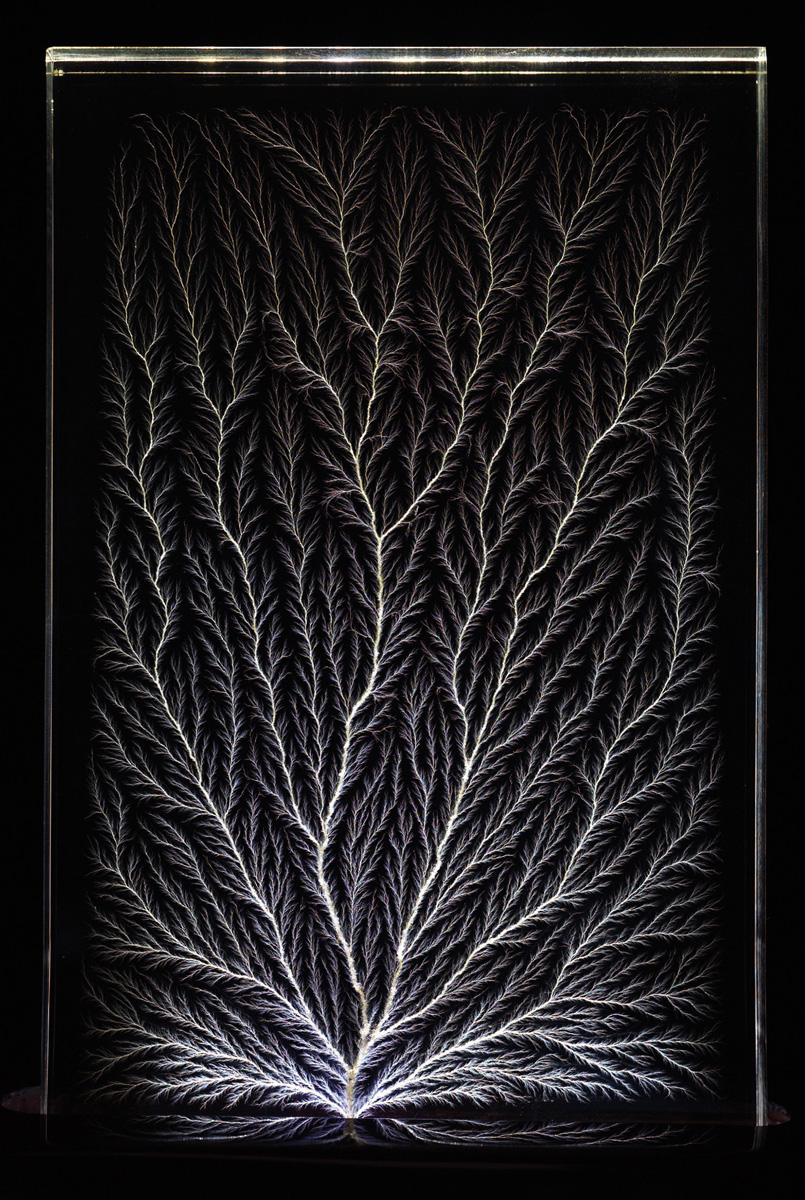Captured Lightning
The fractal beauty of Lichtenberg Figures
Margaret Wertheim

In 1778, the German polymath Georg Christoph Lichtenberg published a satire poking fun at the then fashionable theory of Johann Caspar Lavater that people’s characters could be read from their portrait silhouettes. The object of Lichtenberg’s own study was tails, and in Über Physiognomik wider die Physiognomen he analyzed the “expressive qualities” of dogs’ tails, pigs’ tails, and gentlemen’s ponytails, all presented in silhouette. His tone was a parody of Lavater’s lugubrious style: “What kindliness in the silky tender rope,” he gushed about one noble pigtail, “effective without any masking, hemp-hiding ribbon, and yet smiling bliss like plaited sunbeams, soaring as far above even crowned heads as a saint’s halo over a nightcap.” Though Lichtenberg’s writings are little known in the English-speaking world, he is recognized as one of the leading German satirists of the eighteenth century and counts among his admirers Goethe, Kant, Tolstoy, and Breton. A collection of his thoughts on everything from religion and philosophy to household chores and the charms of serving girls, which he wrote down in what he called his “waste books,” is credited with introducing the aphorism to German literature. Both Nietzsche and Wittgenstein noted his influence on the formation of their philosophies and Freud acknowledged his prior interest in dreams.
Lichtenberg has been described by one of his fans as “a charming, lecherous, hunchbacked hypochondriac.” Voraciously curious and wide-ranging in his interests, he was also an accomplished scientist. As a professor at the University of Göttingen, he taught chemistry, geology, physics, and astronomy and conducted research in geophysics, volcanology, meteorology, mathematics, and a panoply of other scientific fields, an eclecticism still possible in the heyday of the European Enlightenment. Lichtenberg was one of the first to incorporate experiments into his lectures, which attracted students and luminaries from all over Europe. Aside from his writing, his most important work was in the field of physics, particularly his researches into electricity, which led to his major scientific discovery, today known as Lichtenberg Figures.
In Lichtenberg’s original experiments, these figures formed in dust scattered over the surface of an insulating plate when the plate was touched by the tip of a high-voltage conductor. As the electricity discharged, the current tore paths through the fine particles of dust, creating a pattern reminiscent of lightning. These fractal forms are self-similar at every scale. Lichtenberg’s discovery has since been put to use as the basis of photocopy machines and his beautiful figures can now be produced in three-dimensions inside electron beam accelerators.
The master of the contemporary Lichtenberg Figure is Bert Hickman, a retired electrical engineer from Bell Labs. Several years ago, Hickman formed his Illinois-based company Stoneridge Engineering specifically to research and produce high-quality examples of this “captured lightning.” Blocks of clear plastic polymethyl methacrylic (PMMA) are placed inside a linear accelerator (or LINAC) where they are bombarded by electrons carrying up to five million electron volts of kinetic energy and traveling at 99.5% of the speed of light. As the block is bombarded by the beam, electrons are driven deep inside the plastic where they build up in a cloud-like layer of charge called a space charge. Although PMMA is a good insulator, eventually the rising electric field tears apart the bonds between the acrylic molecules, leading to dielectric breakdown. Electrons rip through the plastic toward a discharge point in the process, creating a brilliant flash of white light accompanied by a loud bang.
The process is much the same as that which produces lightning in the atmosphere, but here the strike is captured permanently, for the movement of the electrons melts the acrylic and leaves a delicate spidery record of their journey. When first made, Lichtenberg Figures often have an amber or greenish tint, called solarization, caused by ionizing radiation. As the beam electrons slow down when they enter the block, they release kinetic energy in the form of X-rays, which in turn are absorbed by the acrylic molecules. Called Bremstrahlung or “braking radiation,” it is this which produces the yellowish hue within the acrylic block. As time passes, the coloring fades. It can also be dissipated by heating the block gently in the oven.
Creating finely wrought Lichtenberg Figures is as much an art as a science, says Hickman. Beam voltage, ambient temperature, and the specific composition and geometry of the acrylic block all affect the result. In his most recent run on the LINAC, Hickman and his two physicist collaborators, Kim Goins and Bill Hathaway, were able to produce larger, clearer, and more varied figures than ever before, including ones inside acrylic spheres.
For more information about Lichtenberg Figures, see Hickman’s website, www.teslamania.com.
Margaret Wertheim is director of the Los Angeles-based Institute for Figuring, an organization devoted to enhancing the public understanding of figures and figuring techniques. Also a science writer, she pens the “Quark Soup” column for the LA Weekly, and is currently working on a book about the role of imagination in theoretical physics. See www.theiff.org
Spotted an error? Email us at corrections at cabinetmagazine dot org.
If you’ve enjoyed the free articles that we offer on our site, please consider subscribing to our nonprofit magazine. You get twelve online issues and unlimited access to all our archives.